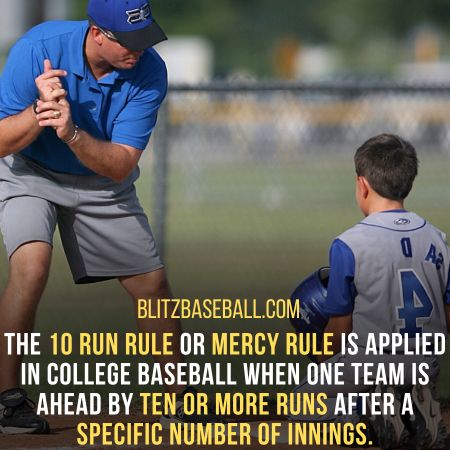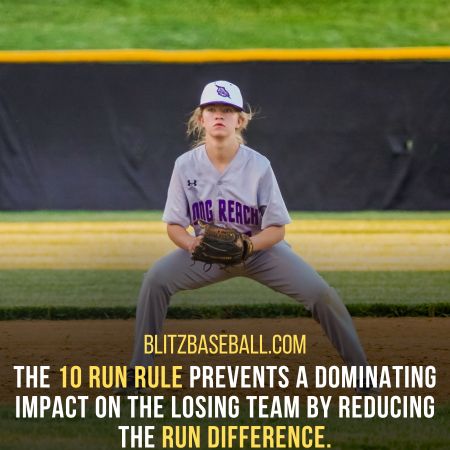A common question in the world of baseball: ‘Is there a 10 run rule in college baseball?’ In college baseball, the use of a 10 Run Rule, also known as the Mercy Rule, has been a topic of debate and discussion.
This rule allows for a game to be called off if one team is leading by ten or more runs after a specific number of innings.
The implementation of the Mercy Rule aims to shorten the length of the game and alleviate pressure on players and pitchers, while also preventing a dominating impact on the losing team. However, there are limitations to this rule as game situations can change quickly.
This article will explore the existence and effectiveness of the 10 Run Rule in college baseball. It will examine the benefits of the Mercy Rule, such as reducing game length and saving energy, as well as its limitations.
Additionally, considerations for the NCAA in regards to the implementation and potential modifications of this rule will be discussed.
Key Takeaways
- The 10 Run Rule or Mercy Rule is applied in college baseball when one team is ahead by ten or more runs after a specific number of innings.
- The Mercy Rule can help reduce the length of games and save energy for both teams.
- It can also benefit pitchers by reducing pressure and the need for additional pitchers.
- The 10 Run Rule prevents a dominating impact on the losing team by reducing the run difference.
Mercy Rule Explanation: Is There A 10 Run Rule In College Baseball?
The Mercy Rule, also known as the 10 Run Rule, is a regulation in college baseball that allows the game to be called off if one team is ahead by ten or more runs after a specific number of innings, typically nine, but can be shorter in certain situations.
The implementation of the Mercy Rule aims to shorten the game length and prevent a dominating impact on the losing team.
By ending the game early, it reduces the amount of time and energy expended by both teams. Additionally, the Mercy Rule benefits pitchers by alleviating the pressure and reducing the need for additional pitchers.

However, it is important to note that the Mercy Rule does not guarantee a win for the team with ten runs. Despite its advantages, the Mercy Rule has limitations, as the game situation can change quickly. As a result, the NCAA is considering implementing a more regular Mercy Rule to address these concerns.
Benefits of the Mercy Rule
One advantage of implementing the Mercy Rule in college baseball is its potential to shorten game duration and conserve energy.
By ending the game early when one team is leading by ten or more runs, the Mercy Rule reduces the number of innings played, thus saving time and energy for both the players and the spectators.
This can be particularly beneficial in situations where teams have multiple games scheduled in a day or when there are time constraints.
Additionally, the Mercy Rule can have a positive impact on pitchers. With a large lead, there is less pressure on the pitching staff, and fewer pitchers may need to be used, which can help prevent overuse and potential injuries.
Overall, the Mercy Rule’s ability to shorten games and save energy makes it advantageous in college baseball.

Limitations of the Mercy Rule
A potential drawback of implementing a mercy rule in college baseball is that it may not account for potential changes in the game situation.
While the mercy rule can provide a less heavy ending for the losing team, it may not take into consideration the possibility of a comeback or a shift in momentum.
This can be challenging as it does not allow for the full development of players’ skills and the opportunity to strategize and overcome adversity.
Additionally, the mercy rule may impact player development by reducing playing time for pitchers and limiting their opportunities to face challenging situations. It can also hinder the development of other players who may benefit from additional at-bats or defensive opportunities.
Therefore, careful consideration should be given to the potential limitations and challenges of implementing the mercy rule in college baseball.
Challenges of implementing the mercy rule:nn1. Potential for a comeback or shift in momentum.nn2. Limited development of players’ skills and strategies.nn3. Reduced playing time for pitchers.nn4. Hindered development for other players.
Considerations for the NCAA
Considerations for the NCAA in implementing a mercy rule in college baseball include potential changes in game situations, player skill development, and the impact on playing time for pitchers and other players.
One possible alternative to the Mercy Rule is imposing a run limit after a certain number of innings with a ten-run difference. This would allow the game to continue, but prevent a dominating impact on the losing team.

Another consideration is the impact of the Mercy Rule on player development. Ending a game early may limit opportunities for players to improve their skills and gain valuable experience in competitive situations.
Additionally, the Mercy Rule could potentially affect playing time for pitchers, as it may reduce their opportunities to pitch in a full game. These factors should be carefully evaluated by the NCAA before implementing a more regular Mercy Rule in college baseball.
| Considerations for NCAA | Implementing a Mercy Rule in College Baseball |
|---|---|
| Game Situations | Changes in game situations due to early endings |
| Player Skill Development | Limiting opportunities for skill improvement |
| Impact on Playing Time | Potential reduction in pitching opportunities |
Frequently Asked Questions
How does the Mercy Rule affect the statistics and records of a baseball game?
The Mercy Rule in baseball can have several effects on the statistics and records of a game. It may limit the number of innings played, resulting in fewer opportunities for players to accumulate stats. Additionally, it can impact game strategy, as teams may alter their approach when facing a large deficit or lead. This can affect individual player development and overall team performance.
Are there any exceptions to the Mercy Rule in college baseball?
There are no specific exceptions to the mercy rule in college baseball. However, the impact on player development may vary as the rule can limit playing time and opportunities for skill development in certain situations.
How do coaches and players feel about the implementation of the Mercy Rule in college baseball?
Coaches and players have mixed opinions on the implementation of the mercy rule in college baseball. While some argue that it impacts game dynamics and competitive fairness, others believe it helps save energy, reduces run difference, and benefits pitchers.
Are there any alternative rules or proposals to the Mercy Rule in college baseball?
Proposed changes to the mercy rule in college baseball aim to address its limitations and impact on game dynamics. Alternative rules or proposals could include imposing a run limit after a certain number of innings with a ten-run difference, rather than ending the game early. These changes would provide a more balanced approach while still considering the length and energy-saving benefits of the mercy rule.
What are some examples of notable games where the Mercy Rule was applied in college baseball?
Some notable games where the mercy rule was applied in college baseball include [insert examples here]. The application of the mercy rule can have an impact on player morale, as it provides a less heavy ending for the losing team.
